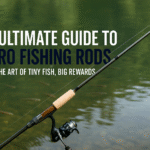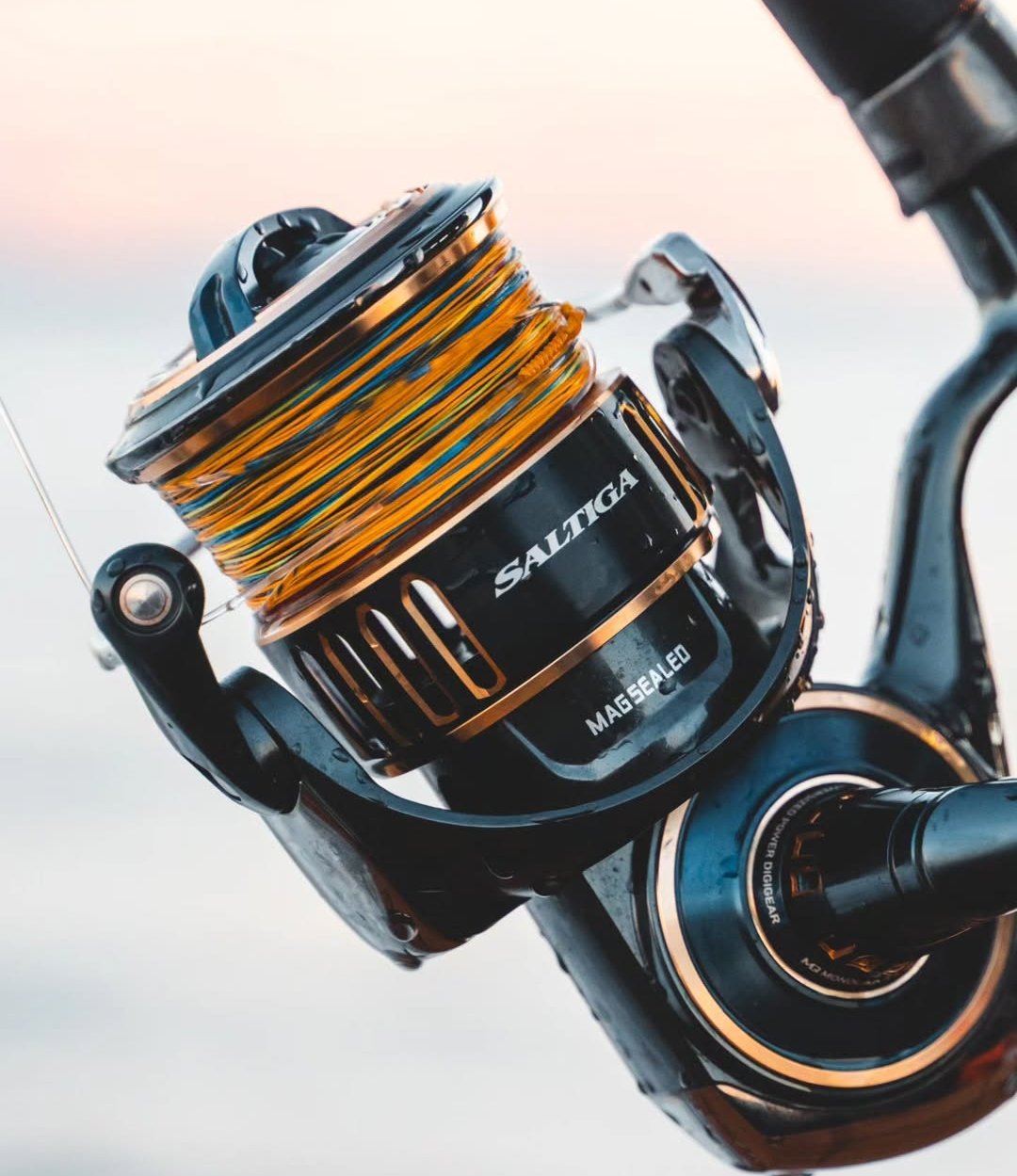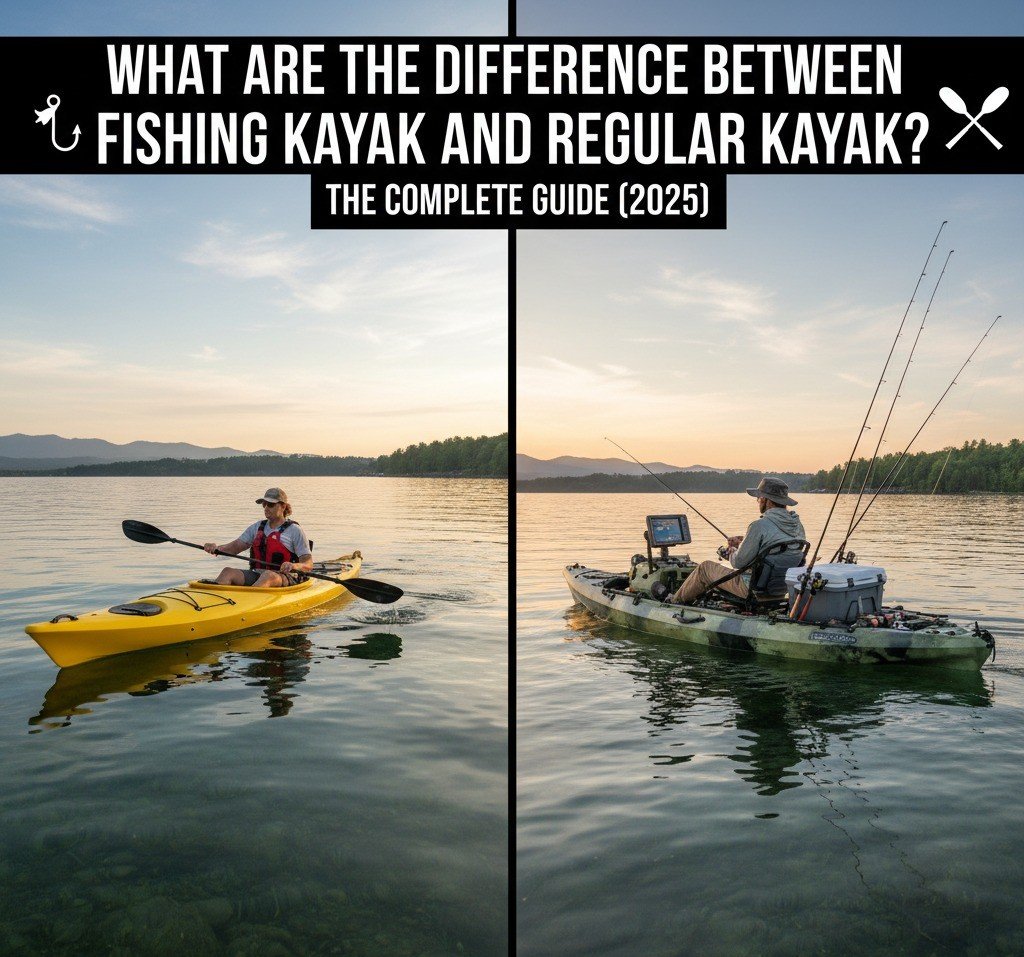
While both types float and get you on the water, the difference between fishing kayak and regular kayak could mean the difference between landing that trophy bass or watching it swim away. 🎣
I learned this lesson the hard way when I first started kayak fishing. Picture this: I’m out on the lake in my sleek touring kayak, rod precariously balanced across my lap, tackle box wedged between my knees. Just as I hook into a decent largemouth, I reach for my net and—splash!—there goes my tackle box into the depths. That’s when I realized that not all kayaks are created equal, especially when it comes to fishing.
The problem is clear: choosing the wrong kayak type leads to poor fishing experiences, lost gear, and potentially wasted money. But here’s the good news—understanding the practical differences between fishing and regular kayaks will help you make an informed decision that matches your needs perfectly.
After testing dozens of kayaks and logging hundreds of hours on the water, I’ve identified seven critical differences that actually affect performance and value. Whether you’re considering your first kayak purchase or thinking about upgrading, this comprehensive guide will help you understand exactly what sets these two kayak types apart.
Key Takeaways
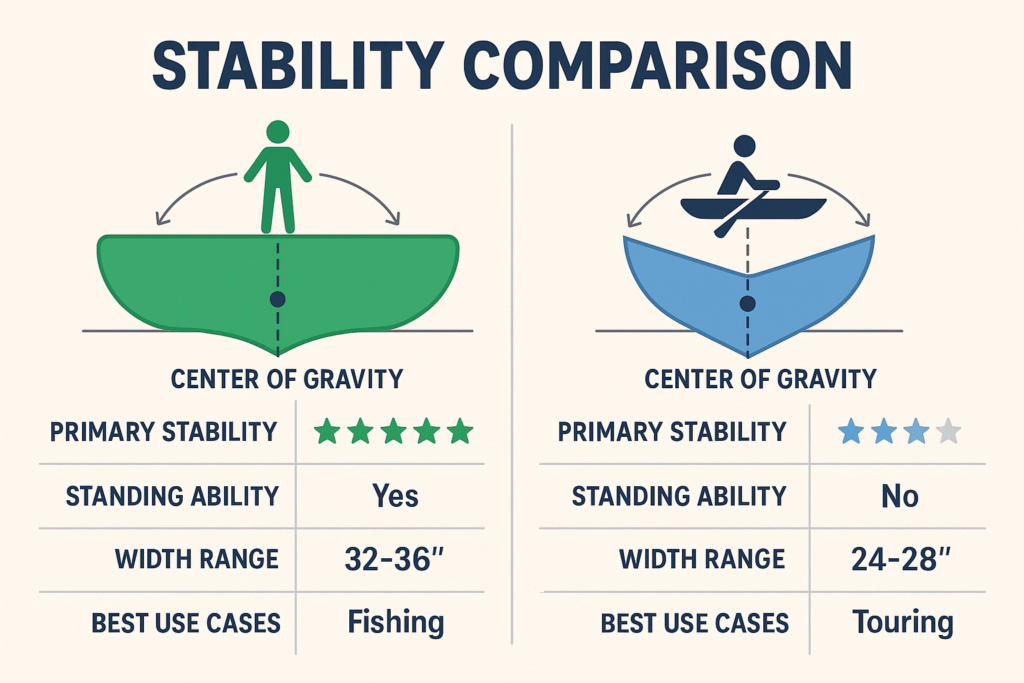
- Stability is paramount: Fishing kayaks prioritize primary stability with wider, flatter hulls, allowing anglers to stand and cast safely
- Storage matters: Purpose-built fishing kayaks include specialized compartments, rod holders, and gear tracks that regular kayaks lack
- Weight capacity differences: Fishing kayaks typically support 100-200 pounds more gear than recreational models
- Price reflects purpose: Expect to pay 30-50% more for a fishing kayak, but the specialized features often justify the cost
- Modification has limits: While you can add fishing accessories to regular kayaks, you can’t change fundamental hull characteristics
The 7 Key Difference Between Fishing kayak and Regular Kayak
Fishing vs Regular Kayak Comparison
Compare key features and characteristics
| Feature | Fishing Kayak | Regular Kayak |
|---|---|---|
| Stability | Excellent – Wide beam (32-36″), flat hull design | Good – Narrower V-shaped hull, less stable at rest |
| Speed | 3-4 mph cruising speed | 4-6 mph cruising speed |
| Weight Capacity | 400-600 lbs average capacity | 250-350 lbs average capacity |
| Storage | Specialized – Rod holders, tackle compartments, gear tracks | Basic – Sealed hatches, deck bungees |
| Seating | Elevated stadium-style, adjustable, excellent back support | Low-profile, basic padding, minimal back support |
| Accessories | Built-in track systems, mounting points, cable routing | Limited – No integrated mounting systems |
| Price Range | $400 – $4,000+ (premium models) | $200 – $1,500 (generally lower) |
| Best For | Calm lakes, slow rivers, protected bays, serious angling | Open water, fast rivers, ocean, recreational paddling |
🎣 Fishing Kayak
Pros
- Superior stability for standing and fighting fish
- High weight capacity (400-600 lbs)
- Built-in rod holders and tackle storage
- Comfortable elevated seating for all-day fishing
- Integrated mounting systems for electronics
- Excellent for shallow water access
Cons
- Slower cruising speed (3-4 mph)
- Higher price point ($400-$4,000+)
- Heavier and harder to transport
- Less maneuverable in tight spaces
- Not ideal for long-distance paddling
🚣 Regular Kayak
Pros
- Faster cruising speed (4-6 mph)
- More affordable price range
- Lighter weight and easier to transport
- Better tracking and maneuverability
- Excellent for recreational paddling
- Suitable for open water and ocean use
Cons
- Less stable for fishing activities
- Lower weight capacity (250-350 lbs)
- Limited specialized fishing storage
- Basic seating with minimal comfort
- No integrated accessory mounting
- Requires aftermarket modifications for fishing
Let’s dive into the core distinctions that separate these two kayak categories. Understanding these differences will help you choose the right vessel for your adventures on the water.
#1. Stability: The Foundation of Fishing Success
The most noticeable difference between fishing kayak and regular kayak lies in their stability profiles. Fishing kayaks are engineered with primary stability as the top priority—the ability to resist capsizing when the water is flat.
Hull Design Differences
Fishing kayaks typically feature:
- Flat or pontoon-style hulls that maximize surface contact with water
- Wider beams (32-36 inches vs. 24-28 inches for regular kayaks)
- Lower center of gravity for enhanced stability
- Chine rails that provide additional stability at rest
Regular kayaks, particularly touring models, use:
- V-shaped or rounded hulls for efficient paddling
- Narrower profiles for speed and tracking
- Higher secondary stability (stability when leaned)
- Streamlined designs that sacrifice stability for performance
“The width of a fishing kayak makes all the difference when you’re trying to land a fish. That extra stability means you can focus on the catch, not on staying upright.” – Professional Guide, Arkansas River
Standing Capability Comparison
Here’s where the rubber meets the road—or rather, where your feet meet the deck:
| Feature | Fishing Kayak | Regular Kayak |
|---|---|---|
| Standing Stability | Excellent (most models) | Poor to None |
| Deck Space | Wide, flat platforms | Narrow, curved decks |
| Weight Distribution | Optimized for standing | Designed for seated paddling |
| Balance Points | Multiple stable positions | Single seated position |
The trade-off? Fishing kayaks sacrifice speed and maneuverability for that rock-solid platform. While my touring kayak cuts through water like a knife, my fishing kayak feels more like a stable barge—and that’s exactly what I want when I’m wrestling with a 5-pound bass!
#2. Storage and Equipment Capacity
Storage isn’t just about space—it’s about accessibility and organization while you’re actively fishing. This is where fishing kayaks truly shine.
Built-in Features vs. Aftermarket Solutions
Fishing kayaks come equipped with:
- Multiple rod holders (2-6 flush-mounted positions)
- Tackle storage compartments within arm’s reach
- Bait wells or cooler spaces
- Gear tracks for mounting accessories
- Bungee storage systems for quick access
Regular kayaks typically offer:
- Sealed hatches for dry storage
- Deck bungees for securing gear
- Limited mounting options without modification
- Cockpit storage (in sit-inside models)
I remember trying to retrofit my first recreational kayak for fishing. After drilling holes for rod holders and adding milk crates, it still couldn’t match the thoughtful design of a purpose-built fishing kayak. The fishing rods for kayak fishing need proper support, and fishing kayaks deliver that from the factory.
Gear Organization Systems
Modern fishing kayaks feature:
- Center console storage with tackle trays
- Under-seat storage for larger items
- Side-mounted tool holders
- Integrated measuring boards
- Cup holders (because coffee and fishing go hand-in-hand! ☕)
#3. Weight Capacity and Load Distribution
Here’s a sobering fact: the average angler carries 50-100 pounds of gear, not including their body weight. Fishing kayaks are built to handle this load.
Typical Weight Capacity Differences
| Kayak Type | Average Capacity | Usable Capacity* |
|---|---|---|
| Fishing Kayak | 400-600 lbs | 300-450 lbs |
| Recreational Kayak | 250-350 lbs | 175-250 lbs |
| Touring Kayak | 300-400 lbs | 200-300 lbs |
*Usable capacity = Total capacity minus safety margin (25-30%)
Load Distribution for Fishing Gear
Fishing kayaks excel at:
- Even weight distribution across the hull
- Low center of gravity when loaded
- Minimal performance degradation with gear
- Stable trim regardless of load position
When I load up for a day of kayak fishing in Arkansas, my gear list includes:
- Rods and reels (15-20 lbs)
- Tackle boxes (10-15 lbs)
- Electronics and battery (15-25 lbs)
- Cooler with ice (20-30 lbs)
- Safety gear (5-10 lbs)
- Personal items (5-10 lbs)
That’s easily 70-110 pounds before catching a single fish! 🐟
#4. Hull Design and Performance Characteristics
The hull is where form meets function, and the difference between fishing kayak and regular kayak in performance becomes crystal clear.
Design Philosophy Comparison
Fishing kayaks prioritize:
- Stability over speed (typically 3-4 mph cruising)
- Minimal drift in current or wind
- Shallow draft for accessing skinny water
- Durability over weight savings
Regular kayaks emphasize:
- Efficiency and speed (4-6 mph cruising)
- Tracking ability for long-distance paddling
- Maneuverability in various conditions
- Lightweight construction for easy transport
Water Conditions Suitability
Different hull designs excel in different environments:
Fishing Kayak Performance:
- ✅ Calm lakes and ponds
- ✅ Slow-moving rivers
- ✅ Protected bays and coves
- ⚠️ Open water with waves
- ❌ Whitewater rapids
Regular Kayak Performance:
- ✅ Open water touring
- ✅ Fast-moving rivers
- ✅ Ocean paddling (sea kayaks)
- ⚠️ Standing or fishing activities
- ✅ Multi-day expeditions
#5. Seating and Comfort for Extended Use
If you’ve never spent 8 hours in a kayak seat, trust me—comfort isn’t a luxury, it’s a necessity. Fishing kayaks understand this assignment.
Elevated Seating Positions
Modern fishing kayaks feature:
- High-low adjustable seats for sight fishing
- Stadium-style seating with back support
- Breathable mesh materials for all-day comfort
- Swivel capabilities on some models
- Removable designs for shore lunch breaks
The Feel Free Lure 13.5 fishing kayak exemplifies this with its revolutionary Gravity Seat system, allowing anglers to adjust height on the fly.
All-Day Comfort Considerations
| Comfort Feature | Fishing Kayak | Regular Kayak |
|---|---|---|
| Seat Padding | Thick, ergonomic | Basic to moderate |
| Back Support | High, adjustable | Low to moderate |
| Leg Room | Spacious, open | Confined (sit-in) |
| Position Options | Multiple | Single |
| Breathability | Excellent | Variable |
#6. Mounting Systems and Accessory Integration
This is where fishing kayaks really separate themselves from the pack. The ability to customize your setup is crucial for serious anglers.
Track Systems and Mounting Points
Fishing kayaks include:
- H-Rail or track systems (2-4 tracks standard)
- Scotty or RAM mount compatibility
- Pre-drilled mounting points
- Reinforced areas for heavy accessories
- Power cable routing channels
Electronics Integration Capabilities
Modern fishing kayaks accommodate:
- Fish finders and GPS units
- Trolling motors (bow or stern mount)
- LED lighting systems
- Camera mounts for recording catches
- Power systems and battery storage
I’ve seen anglers transform their fishing kayaks into floating command centers, complete with multiple screens, rod holders, and even trolling motor setups. Try doing that with a regular kayak!
#7. Price Point and Value Proposition
Let’s talk money—because the difference between a fishing kayak and regular kayak extends to your wallet.
Entry-Level Pricing Differences
| Category | Fishing Kayak | Regular Kayak | Price Difference |
|---|---|---|---|
| Budget | $400-$700 | $250-$500 | +60% |
| Mid-Range | $800-$1,500 | $500-$1,000 | +50% |
| Premium | $1,500-$4,000 | $1,000-$2,500 | +60% |
Feature-to-Cost Analysis
When you break down the included features:
- Rod holders (4): $60-$100 if added aftermarket
- Gear tracks: $50-$80 per track
- Upgraded seat: $150-$300
- Storage systems: $50-$150
- Fish finder mount: $30-$50
Suddenly, that price premium doesn’t seem so steep!
When to Choose a Fishing Kayak vs Regular Kayak
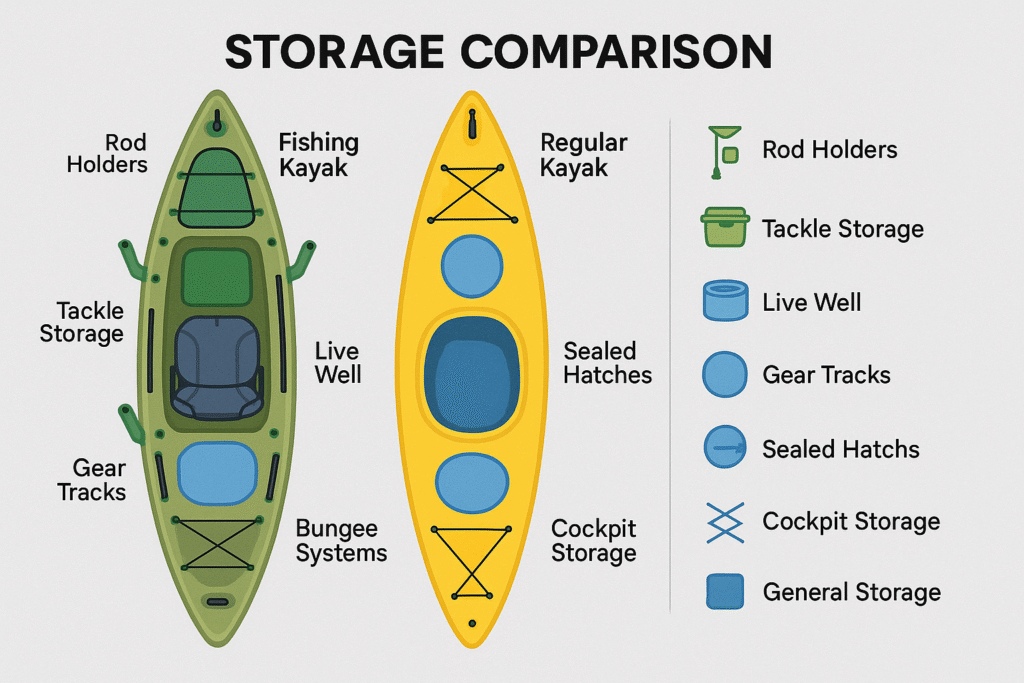
Making the right choice depends on honest self-assessment of your needs and priorities.
Choose a Fishing Kayak If…
✅ Primary activity is angling (80%+ of your time)
✅ Need to carry extensive gear for serious fishing
✅ Fish from standing position for better visibility
✅ Require maximum stability for safety and comfort
✅ Plan to add electronics/accessories for advanced fishing
You know you need a fishing kayak when you find yourself saying things like:
- “I wish I had more rod holders”
- “There’s nowhere to put my tackle”
- “I can’t see the fish from down here”
- “This seat is killing my back”
Choose a Regular Kayak If…
✅ Recreational paddling is primary use
✅ Occasional fishing only (less than 30% of trips)
✅ Speed and maneuverability priority
✅ Budget constraints are significant
✅ Multi-purpose use requirements
Regular kayaks excel when:
- You enjoy kayak camping or touring
- Fitness paddling is a priority
- Storage space is limited at home
- You paddle with non-fishing friends regularly
Hybrid Options and Compromises
Some kayaks try to bridge the gap:
Crossover Models:
- Wilderness Systems Pungo 120 (recreational with fishing features)
- Old Town Vapor 10 Angler (budget-friendly hybrid)
- Perception Pescador Pro (fishing-focused but tour-capable)
These models offer:
- Moderate stability with decent speed
- Basic fishing features without full commitment
- Lower price than dedicated fishing kayaks
- Versatility for mixed-use scenarios
Performance Comparison: Real-World Scenarios

Let’s examine how these differences play out in actual fishing situations.
Stability When Fighting Fish
I’ll never forget the first time I hooked a 30-pound catfish from my kayak. In my fishing kayak, I could:
- Lean hard to counter the fish’s runs
- Use both hands without worrying about balance
- Stand up to gain leverage
- Move around the kayak to optimal fighting position
In a regular kayak? That same fish would’ve likely resulted in a swim! 🏊♂️
Center of Gravity Considerations
Fishing kayaks maintain stability through:
- Lower seating positions relative to water
- Wider stance at the waterline
- Hull shapes that resist rolling
- Weight distribution that favors stability
Paddling Efficiency and Speed
Here’s the trade-off in numbers:
| Metric | Fishing Kayak | Regular Kayak |
|---|---|---|
| Cruising Speed | 2.5-3.5 mph | 3.5-5 mph |
| Energy per Mile | High | Low |
| Glide Efficiency | Poor | Excellent |
| Wind Resistance | High | Low |
| Tracking | Moderate | Excellent |
But here’s the thing—when I’m fly fishing from a kayak, I’m not trying to win races. I’m trying to stay in position and make accurate casts.
Storage Accessibility While Fishing
The real test comes when you need something NOW:
- Hook stuck in your thumb? First aid kit within reach
- Fish of a lifetime on? Camera accessible
- Need different lure? Tackle at your fingertips
- Thirsty? Cup holder right there
This accessibility can make or break your fishing experience.
Cost Analysis: Difference Between Fishing kayak and Regular Kayak

Let’s dive deep into the financial aspects of your kayak decision.
Initial Purchase Price Comparison
Entry-Level Options:
Fishing Kayaks:
- Lifetime Tamarack Angler 10: $450-$550
- Pelican Catch 100: $500-$600
- Sun Dolphin Journey 10 SS: $400-$500
Regular Kayaks:
- Lifetime Daylite 8: $250-$300
- Pelican Trailblazer 100: $300-$400
- Sun Dolphin Aruba 10: $300-$350
Total Cost of Ownership
Don’t forget these additional expenses:
For Fishing Kayaks:
- Paddle upgrade: $100-$300
- PFD (fishing-specific): $80-$200
- Electronics: $200-$1,000
- Additional accessories: $100-$500
- Kayak trailer: $200-$800
For Regular Kayaks (converted to fishing):
- Aftermarket rod holders: $60-$150
- Seat upgrade: $150-$300
- Mounting systems: $100-$200
- Storage solutions: $50-$150
- Stability outriggers: $150-$300
When you add it all up, converting a regular kayak often costs nearly as much as buying a dedicated fishing kayak!
Resale Value and Depreciation
Based on market analysis:
- Fishing kayaks retain 60-70% of value after 2 years
- Regular kayaks retain 50-60% of value after 2 years
- Well-maintained fishing kayaks sell faster
- Seasonal demand affects fishing kayaks more
Popular Models Comparison: Fishing vs Regular

Let’s look at specific models to illustrate the differences.
Entry-Level Fishing Kayaks
Lifetime Tamarack Angler 10
- Weight capacity: 275 lbs
- Features: 2 rod holders, paddle cradle, storage hatch
- Stability: ★★★★☆
- Price: $450-$550
- Best for: Budget-conscious beginners
Pelican Bass Raider 10E
- Weight capacity: 325 lbs
- Features: 4 rod holders, front storage platform
- Stability: ★★★★★
- Price: $600-$700
- Best for: Dedicated bass fishing
Entry-Level Regular Kayaks
Lifetime Youth Wave 6
- Weight capacity: 130 lbs
- Features: Basic paddle holder, minimal storage
- Speed: ★★★☆☆
- Price: $150-$200
- Best for: Kids and lightweight paddlers
Pelican Mustang 100X
- Weight capacity: 300 lbs
- Features: Rear storage, comfortable seat
- Speed: ★★★★☆
- Price: $350-$450
- Best for: Recreational paddling
Premium Model Comparisons
The gap widens significantly at the premium level:
Premium Fishing Platform:
- Hobie Pro Angler 14: $3,500-$4,500
- Features: Pedal drive, 6 rod holders, tackle storage, standing platform
Premium Touring Kayak:
- Wilderness Systems Tempest 170: $1,800-$2,200
- Features: Sealed bulkheads, day hatch, excellent tracking
The best fishing kayaks of 2025 showcase just how specialized these vessels have become.
Modification Potential: Making Regular Kayaks Fish-Ready
Can you turn a regular kayak into a fishing machine? Yes, but with limitations.
Essential Fishing Modifications
What You Can Add:
- Flush-mount rod holders ($20-$40 each)
- Requires drilling and sealing
- Placement crucial for balance
- Gear tracks ($30-$50 per track)
- Surface-mounted options available
- Limited by hull shape
- Anchor trolley system ($40-$80)
- Essential for position holding
- Works on most kayak types
- Crate storage systems ($30-$100)
- Milk crate with PVC rod holders
- Bungee attachment to rear deck
Modification Costs vs. Purpose-Built
Here’s the reality check:
| Modification | DIY Cost | Professional Install | Fishing Kayak Feature |
|---|---|---|---|
| Rod Holders (4) | $80-$160 | $200-$300 | Included |
| Gear Tracks (2) | $60-$100 | $150-$200 | Included |
| Anchor System | $40-$80 | $100-$150 | Often included |
| Electronics Mount | $30-$60 | $80-$120 | Integrated |
| Total | $210-$400 | $530-$770 | $0 |
What You Can’t Change
No amount of modification can alter:
- Basic hull stability – A narrow touring kayak will always be tippy
- Weight capacity – Structural limits are fixed
- Primary stability – Hull shape determines this
- Standing capability – Without width, standing remains dangerous
I learned this the hard way after spending $300 modifying a regular kayak, only to sell it six months later for a proper fishing kayak. Sometimes, it’s better to buy once and cry once! 💸
Making the Right Choice: Decision Framework
Let’s create a clear path to your ideal kayak choice.
Assess Your Primary Use Case
Calculate Your Fishing Percentage:
- 90-100% fishing → Dedicated fishing kayak
- 60-89% fishing → Fishing kayak or high-end hybrid
- 30-59% fishing → Crossover model
- Under 30% fishing → Regular kayak with basic mods
Consider Your Fishing Style:
- Stand-up sight fishing → Wide, stable fishing kayak
- Trolling → Kayak with rod holders and good tracking
- Fly fishing → Maximum stability and clear casting space
- Casual bait fishing → Basic fishing features sufficient
Budget and Feature Prioritization
Must-Have Features Checklist:
For Serious Anglers:
- [ ] Standing capability
- [ ] Multiple rod holders
- [ ] High weight capacity
- [ ] Gear track systems
- [ ] Comfortable high seat
For Occasional Fishers:
- [ ] Basic stability
- [ ] 2+ rod holders
- [ ] Some storage
- [ ] Decent seat
- [ ] Paddle holder
Long-Term Satisfaction Factors
Think ahead 2-3 years:
- Will your fishing interest grow?
- Might you upgrade techniques? (Using advanced reels)
- Planning fishing vacations? (Hilton Head kayak fishing)
- Family members interested?
- Storage and transport limitations?
🚣 Kayak Selection Tool: Find Your Perfect Match 🎣
Your Recommendation
Adjust the settings above to get your personalized kayak recommendation!
Frequently Asked Questions
Can you fish from any kayak?
Technically, yes—you can fish from any kayak. However, regular kayaks make fishing significantly more challenging. You’ll struggle with:
- Limited gear storage
- Poor stability when casting
- No rod management system
- Uncomfortable seating for long trips
- Difficulty landing fish safely
It’s like asking if you can hunt in dress shoes—possible, but far from ideal!
Are fishing kayaks harder to paddle?
Yes, fishing kayaks typically require more effort to paddle due to:
- Wider hull creating more drag
- Heavier weight (10-30 lbs more)
- Less efficient hull shapes
- Higher wind resistance profile
Expect to paddle 20-30% harder to maintain the same speed as a regular kayak. However, most anglers gladly trade efficiency for stability and fishing features.
Do I need a fishing kayak to catch fish?
No, you don’t need a fishing kayak to catch fish. I’ve caught plenty from regular kayaks, canoes, and even paddleboards! However, a fishing kayak will:
- Increase your success rate
- Improve safety and comfort
- Allow for more techniques
- Handle bigger fish better
- Make the experience more enjoyable
Think of it like fishing without a tackle box—possible, but why make it harder?
What’s the minimum width for a stable fishing kayak?
For comfortable fishing stability:
- Minimum width: 30 inches
- Recommended width: 32-34 inches
- Maximum practical width: 36 inches
Remember, stability also depends on:
- Hull shape and design
- Your height and weight
- Weight distribution
- Water conditions
Can regular kayaks be modified for fishing?
Yes, but with significant limitations:
Successful Modifications:
- Adding 2-4 rod holders
- Installing anchor systems
- Mounting basic electronics
- Adding storage crates
Unsuccessful Attempts:
- Improving basic stability
- Increasing weight capacity
- Creating standing platforms
- Major hull modifications
As one FishMaster Guide reader told me: “I spent $400 trying to make my touring kayak fish-ready. Should’ve just bought a fishing kayak from the start!”
Conclusion
After exploring the seven key differences between fishing kayaks and regular kayaks, the choice becomes clearer. Fishing kayaks excel in stability, storage, capacity, and purpose-built features that make angling more productive and enjoyable. Regular kayaks offer superior speed, efficiency, and versatility for general paddling activities.
The difference between fishing kayak and regular kayak isn’t just about features—it’s about matching your vessel to your passion. If fishing is your primary goal, the extra investment in a dedicated fishing kayak pays dividends in comfort, capability, and catches.
Your Next Steps:
- Honestly assess your fishing vs. paddling ratio
- Set a realistic budget including accessories
- Test paddle both types at a local dealer
- Read reviews of specific models in your price range
- Consider used options for better value
- Join local kayak fishing groups for firsthand advice
Remember, the best kayak is the one that gets you on the water doing what you love. Whether that’s chasing trophy bass from a fully-rigged fishing platform or exploring scenic waterways in a sleek touring kayak, choose the vessel that matches your adventures.
Tight lines and smooth paddling! 🎣🚣♂️


